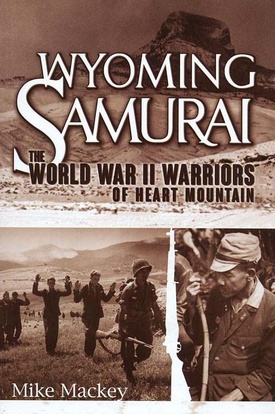This is Mike Mackey’s fifth and, apparently, final book centered on the World War II experience of the Heart Mountain Relocation Center in northwest Wyoming. Mackey, who has made his home in both Powell and Cody, the two communities nearest to Heart Mountain, is exceedingly well informed on the camp’s history and passionately dedicated to its historical interpretation and legacy.
Accordingly, it has always shocked and saddened me that as a professional historian, Mackey’s knowledge and commitment relative to Heart Mountain has not, for one or another reason, been translated into a teaching position for him at Northwest College in Powell and/or an appointment to the staff of the Heart Mountain Interpretive Center.
As for Wyoming Samurai, it is a comparatively brief yet highly useful case study of the salient role played by the issue of military service at Heart Mountain—more so, in fact, than at any of the other nine American-style concentration camps for Americans of Japanese ancestry administered by the War Relocation Authority.
Without exception, all of the WRA confinement centers’ inmate populations seethed with resentment at the U.S. government’s 1942 decisions to discharge American-citizen Nisei from the military because of their ancestry, to relegate those remaining in uniform to servile duties, and to downgrade the draft status of Nisei to 4C (aliens or any group of persons not acceptable for military service).
Then, too, virtually all of the WRA detention camps’ incarcerated denizens took umbrage at the War Department’s 1943 determination to open army enlistment to Japanese Americans for volunteer service in a segregated unit. Finally, there was fairly widespread opposition within the 10 WRA penal colonies to the War Department’s 1944 policy of reopening the military draft to Nisei as a way of reclaiming some of their lost citizenship rights and offering them a chance to demonstrate their loyalty as Americans.
What made the situation at Heart Mountain qualitatively different from that of its counterpart lockups was first, the degree to which the implementation of the segregated volunteer unit and the resumption of the Nisei draft was contested, and second, the character of that contestation. As Mackey points out, whereas the number of volunteers from the WRA camps fell dramatically below government expectations, “the recruiting program at Heart Mountain was among the least successful” (pp. 37). In the case of the resumption of the Nisei draft, Heart Mountain, percentage-wise, spawned the most Nisei who resisted the military draft.
In terms of the type of challenge mounted, respectively, to the segregated volunteer unit for Nisei and the subsequent drafting of them into the military, what made Heart Mountain distinctive is that in each instance it was both organized and principled. With regard to the former circumstance, the dissent-protest-resistance in early 1943 was led by Nisei Frank Inouye, a University of California, Los Angeles senior at the time of his incarceration. It took shape in the formation of an organization called the Heart Mountain Congress of American Citizens. To quote Mackey, “The Congress adopted fourteen resolutions which fell into several categories: clarification of citizenship status, halting (the loyalty) registration until clarification was obtained, and implied consent of the Nisei to serve in the Army once their citizenship was clarified” (pp. 30). These resolutions were fueled by a burning question: Why should American citizens volunteer to serve in the army of a government that had imprisoned them behind barbed wire?
With respect to the Heart Mountain Fair Play Committee-led Nisei draft resistance movement, it was fathered by Kiyoshi Okamoto, a Congress of American Citizens activist, as a one-person operation before morphing into a formal organization, replete with officers and a swelling membership. By March of 1944, the FPC declared that its membership would “refuse to report for their physical examinations or to the induction if or when called, in order to contest the issue,” and thereupon began taking that precise step in substantial numbers. This activity climaxed in two celebrated trials held in Cheyenne’s federal district court, the first in June 1944 for 63 draft resisters (in the largest mass trial in Wyoming history) and the second in October/November 1944 for seven FPC leaders on the grounds of conspiring to impede the draft. In both cases, convictions and federal penitentiary imprisonment terms resulted, though in 1945 the FPC leaders had their jail sentences overturned by a federal court of appeals in Denver and in 1947 President Harry Truman granted the Nisei draft resisters a full pardon.
While Mackey accords the draft resistance movement at Heart Mountain ample space and judicious respect, the heart of his book — chapters five through seven — is devoted to the military participation of Heart Mountain’s men and women (although the role of the latter is simply noted and not developed). Much of what is covered in this section of Wyoming Samurai represents a condensation of the standard issue version of the heroic record achieved during World War II by Japanese American soldiers of the 100th Battalion, the 442nd Regimental Combat Team in Europe and the Military Intelligence Service in the Pacific. Mackey wisely accents his war narrative with the notable actions of select Heart Mountain soldiers, and usefully provides an appendix representing an Honor Roll for all of Heart Mountain’s many enlistees.
Wyoming Samurai is well written and documented and recommends itself both to a general readership and as an assigned text for high school and lower-division college students. Moreover, it should be made required reading in Wyoming’s secondary schools.
Wyoming Samurai: The World War II Warriors of Heart Mountain
By Mike Mackey
(Cody, Wyo.: Western History Publications, 2015, 181 pp., $18.95, paperback)
*This article was originally published in the Nichi Bei Weekly on January 1, 2018.
© 2018 Arthur A. Hansen and Nichi Bei Weekly








